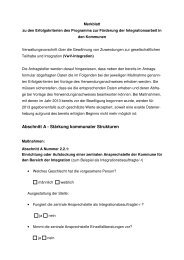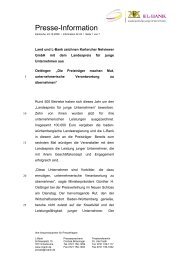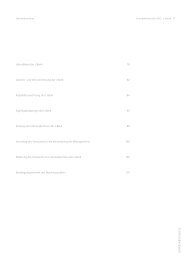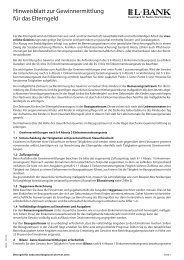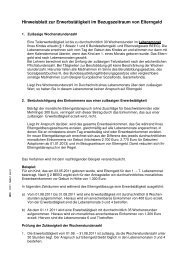Landeskreditbank Baden-Württemberg - L-Bank
Landeskreditbank Baden-Württemberg - L-Bank
Landeskreditbank Baden-Württemberg - L-Bank
Create successful ePaper yourself
Turn your PDF publications into a flip-book with our unique Google optimized e-Paper software.
The credit risk of the loan and securities portfolio is continuously assessed with respect to each individual<br />
exposure. Specific provisions are established in the loan portfolio and in the current asset securities portfolio held<br />
as liquidity reserve by writing down the book value of each such item according to its assessed risk<br />
(Einzelwertberichtigung). In addition, a general provision is established for risk that is not individually<br />
identifiable but is inherent in the loan portfolio (Pauschalwertberichtigung). Like specific provisions, general<br />
provisions are deducted from the assets reserved against and are therefore not shown separately on the balance<br />
sheet.<br />
Under U.S. GAAP, general, unspecified reserves are not permitted. For loans that are individually deemed<br />
impaired, specific reserves are determined based on the present value of future cash flows discounted at the<br />
loan’s effective interest rate, or where the loan is collateral based on the fair value of the collateral provided.<br />
Where available, the observable market price of the loan can be used. U.S. GAAP requires recognition of a loss<br />
when (a) information available prior to issuance of the financial statements indicates that it is probable that an<br />
asset has been impaired at the date of the financial statements and (b) the amount of the loss can be reasonably<br />
estimated, even though the particular loans that are not collectible may not be identifiable.<br />
Certain provisions and reserves<br />
There are two provisions in the German Commercial Code (Handelsgesetzbuch), which allow banks to<br />
establish reserves against general banking risks. Pursuant to Section 340g German Commercial Code banks may<br />
carry a special item called “Fund for General <strong>Bank</strong>ing Risks” (Sonderposten für allgemeine <strong>Bank</strong>risiken) on the<br />
liability side of their balance sheet for protection against general banking risks. However, such a fund may only<br />
be established if, in accordance with reasonable commercial judgment, the special risks inherent in the business<br />
of banks require the establishment of such a fund. Any additions to the Fund for General <strong>Bank</strong>ing Risks or any<br />
profits derived from its dissolution must be reflected separately in the bank’s income statement, (see Section<br />
340g(2), German Commercial Code), see “Glossary.” Funds for general banking risks established pursuant to<br />
Section 340g German Commercial Code are counted as part of core capital.<br />
In addition, banks may have contingency reserves for general banking risk, which are permitted by section<br />
340f German Commercial Code. According to this rule, a bank may record on its balance sheet certain<br />
receivables, debt securities and equity securities that are held as part of the “liquidity reserve” at a lower value<br />
than that permitted for industrial and other nonbanking corporations, if this is necessary, in accordance with<br />
reasonable commercial judgment, to safeguard against the special risks inherent in the business of banks. The<br />
reserves created by such recording of lower values may not exceed four percent of the total book value of such<br />
receivables and securities. <strong>Bank</strong>s need not report in their financial statements on the creation and dissolution of<br />
such reserves for general banking risks. With respect to presentation in the income statement, banks are permitted<br />
to offset (without disclosure) profits from the sale of certain securities (in the so-called liquidity portfolio) and<br />
the revaluation of receivables (i.e., payments received on loans previously written-off or write-backs of risk<br />
provisions) against write-downs of the respective receivables and securities. Based on the foregoing, we disclose<br />
the net result from movements in risk provisions and management of the liquidity portfolio.<br />
Assets, liabilities and pending transactions have been valued in accordance with general provisions of<br />
Sections 252 et seq. of the German Commercial Code, taking into account the special rules applying to credit<br />
institutions, Sections 340e et seq. of the German Commercial Code.<br />
Under U.S. GAAP, provisions are only recorded when certain criteria are met. A provision is only<br />
recognized when (a) information available prior to issuance of the financial statements indicates that it is<br />
probable that an asset has been impaired at the date of the financial statements and (b) the amount of the loss can<br />
be reasonably estimated.<br />
Derivative Instruments and Hedge Accounting<br />
Under German GAAP, derivative instruments and embedded derivatives may be included in a financial<br />
institution’s trading book or investment book. Trading derivatives are treated as current assets and accordingly<br />
83



